Synoptic and Dynamic Analyses of an Intense Mediterranean Cyclone: A Case Study
Abstract
1. Introduction
2. Data and Methods
2.1. Data
2.2. Methods
2.2.1. Temperature Advection
2.2.2. Relative Vorticity Equation
2.2.3. The Equation of the Atmospheric Kinetic Energy
3. Results and Discussion
3.1. Synoptic Analysis
3.2. Analysis of Satellite Data
3.3. Analysis of Temperature Advection
3.4. Isobaric Relative Vorticity Analysis
3.5. Analysis of the Atmospheric Kinetic Energy Budget
4. Conclusions
Funding
Institutional Review Board Statement
Data Availability Statement
Conflicts of Interest
References
- Reale, M.; Cabos Narvaez, W.D.; Cavicchia, L.; Conte, D.; Coppola, E.; Flaounas, E.; Giorgi, F.; Gualdi, S.; Hochman, A.; Li, L.; et al. Future projections of Mediterranean cyclone characteristics using the Med- CORDEX ensemble of coupled regional climate system models. Clim. Dynam. 2022, 58, 2501–2524. [Google Scholar] [CrossRef]
- Ulbrich, U.; Leckebusch, G.C.; Pinto, J.G. Extratropical cyclones in the present and future climate: A review. Theor. Appl. Climatol. 2009, 96, 117–131. [Google Scholar] [CrossRef]
- Ulbrich, U.; Leckebusch, G.C.; Grieger, J.; Schuster, M.; Akperov, M.; Bardin, M.Y.; Feng, Y.; Gulev, S.; Inatsu, M.; Keay, K.; et al. Are greenhouse gas signals of Northern Hemisphere winter extratropical cyclone activity dependent on the identification and tracking algorithm? Meteorol. Z. 2013, 22, 61–68. [Google Scholar] [CrossRef]
- Zappa, G.; Shaffrey, L.C.; Hodges, K.I.; Sansom, P.G.; Stephenson, D.B. A Multimodel Assessment of Future Projections of North Atlantic and European Extratropical Cyclones in the CMIP5 Climate Models. J. Clim. 2013, 26, 5846–5862. [Google Scholar] [CrossRef]
- Pinto, J.G.; Karremann, M.K.; Born, K.; Della-Marta, P.M.; Klawa, M. Loss potentials associated with European windstorms under future climate conditions. Clim. Res. 2012, 54, 1–20. [Google Scholar] [CrossRef]
- Schwierz, C.; Köllner-Heck, P.; Mutter, E.Z.; Bresch, D.N.; Vidale, P.L.; Wild, M.; Schär, C. Modelling European winter wind storm losses in current and future climate. Clim. Change 2010, 101, 485–514. [Google Scholar] [CrossRef]
- Peixoto, J.P.; Oort, A.H. Physics of Climate; American Institute of Physics: College Park, ML, USA, 1992; 520p. [Google Scholar]
- Rudeva, I.; Simmonds, I.; Crock, D.; Boschat, G. Midlatitude fronts and variability in the southern hemisphere tropical width. J. Clim. 2019, 32, 8243–8260. [Google Scholar] [CrossRef]
- Sinclair, V.A.; Rantanen, M.; Haapanala, P.; Räisänen, J.; Järvinen, H. The characteristics and structure of extra-tropical cyclones in a warmer climate. Weather. Clim. Dyn. 2020, 1, 1–25. [Google Scholar] [CrossRef]
- Catto, J.L.; Ackerley, D.; Booth, J.F.; Champion, A.J.; Colle, B.A.; Pfahl, S.; Pinto, J.G.; Quinting, J.F.; Seiler, S. The Future of Midlatitude Cyclones. Curr. Clim. Change Rep. 2019, 5, 407–420. [Google Scholar] [CrossRef]
- Dacre, H.F.; Pinto, J.G. Serial clustering of extratropical cyclones: A review of where, when and why it occurs. Npj Clim. Atmos. Sci. 2020, 3, 48. [Google Scholar] [CrossRef]
- Catto, J.L.; Jakob, C.; Berry, G.; Nicholls, N. Relating Global Precipitation to Atmospheric Fronts. Geophys. Res. Lett. 2012, 39, L10805. [Google Scholar] [CrossRef]
- Hawcroft, M.K.; Shaffrey, L.C.; Hodges, K.I.; Dacre, H.F. How Much Northern Hemisphere Precipitation Is Associated with Extratropical Cyclones? Geophys. Res. Lett. 2012, 39, L24809. [Google Scholar] [CrossRef]
- Pfahl, S.; Wernli, H. Quantifying the relevance of cyclones for precipitation extremes. J. Clim. 2012, 25, 6770–6780. [Google Scholar] [CrossRef]
- Catto, J.L.; Pfahl, S. The Importance of Fronts for Extreme Precipitation. J. Geophys. Res. Atmos. 2013, 118, 10791–10801. [Google Scholar] [CrossRef]
- Hawcroft, M.K.; Shaffrey, L.C.; Hodges, K.I.; Dacre, H.F. Can Climate Models Represent the Precipitation Associated with Extratropical Cyclones? Clim. Dyn. 2016, 47, 679–695. [Google Scholar] [CrossRef]
- Nieto, R.; Ciric, D.; Vázquez, M.; Liberato, M.L.R.; Gimeno, L. Contribution of the main moisture sources to precipitation during extreme peak precipitation months. Adv. Water Resour. 2019, 131, 103385. [Google Scholar] [CrossRef]
- Befort, D.J.; Wild, S.; Knight, J.R.; Lockwood, J.F.; Thornton, H.E.; Hermanson, L.; Bett, P.E.; Weisheimer, A.; Leckebusch, G.C. Seasonal forecast skill for extratropical cyclones and windstorms. Q. J. R. Meteorol. Soc. 2019, 145, 92–104. [Google Scholar] [CrossRef]
- Hewson, T.D.; Neu, U. Cyclones, Windstorms and the IMILAST Project. Tellus Ser. A Dyn. Meteorol. Oceanogr. 2015, 6, 27128. [Google Scholar] [CrossRef]
- Roberts, J.F.; Champion, A.J.; Dawkins, L.C.; Hodges, K.I.; Shaffrey, L.C.; Stephenson, D.B.; Stringer, M.A.; Thornton, H.E.; Youngman, B.D. The XWS Open Access Catalogue of Extreme European Windstorms from 1979 to 2012. Nat. Hazards Earth Syst. Sci. 2014, 14, 2487–2501. [Google Scholar] [CrossRef]
- Kron, W.; Löw, P.; Kundzewicz, Z.W. Changes in risk of extreme weather events in Europe. Environ. Sci. Policy 2019, 100, 74–83. [Google Scholar] [CrossRef]
- Eiras-Barca, J.; Ramos, A.M.; Pinto, J.G.; Trigo, R.M.; Liberato, M.L.R.; Miguez-Macho, G. The concurrence of atmospheric rivers and explosive cyclogenesis in the North Atlantic and North Pacific basins. Earth Syst. Dyn. 2018, 9, 91–102. [Google Scholar] [CrossRef]
- Pradhan, P.K.; Liberato, M.L.R.; Ferreira, J.A.; Dasamsetti, S.; Vijaya Bhaskara Rao, S. Characteristics of different convective parameterization schemes on the simulation of intensity and track of severe extratropical cyclones over North Atlantic. Atmos. Res. 2018, 199, 128–144. [Google Scholar] [CrossRef]
- Seneviratne, S.I.; Nicholls, N.; Easterling, D.; Goodess, C.; Kanae, S.; Kossin, J.; Luo, Y.; Marengo, J.; McInnes, K.; Rahimi, M.; et al. Changes in climate extremes and their impacts on the natural physical environment. In Managing the Risks of Extreme Events and Disasters to Advance Climate Change Adaptation; A Special Report of Working Groups I and II of the Intergovernmental Panel on Climate Change, (IPCC); Field, C.B., Barros, V., Stocker, T.F., Qin, D., Dokken, D.J., Ebi, K.L., Mastrandrea, M.D., Mach, K.J., Plattner, G.-K., Allen, S.K., et al., Eds.; Cambridge University Press: Cambridge, UK; New York, NY, USA, 2012; pp. 109–230. [Google Scholar]
- Leonard, M.; Westra, S.; Phatak, A.; Lambert, M.; van den Hurk, B.; McInnes, K.; Risbey, J.; Schuster, S.; Jakob, D.; Stafford-Smith, M. A Compound Event Framework for Understanding Extreme Impacts. Wiley Interdiscip. Rev. Clim. Change 2014, 5, 113–128. [Google Scholar] [CrossRef]
- Zscheischler, J.; Martius, O.; Westra, S.; Bevacqua, E.; Raymond, C.; Horton, R.M.; van den Hurk, B.; AghaKouchak, A.; Jézéquel, A.; Mahecha, M.D.; et al. A Typology of Compound Weather and Climate Events. Nat. Rev. Earth Environ. 2020, 1, 333–347. [Google Scholar] [CrossRef]
- Raveh-Rubin, S.; Wernli, H. Large-scale wind and precipitation extremes in the Mediterranean: A climatological analysis for 1979–2012. Q. J. R. Meteorol. Soc. 2015, 141, 2404–2417. [Google Scholar] [CrossRef]
- Waliser, D.; Guan, B. Extreme Winds and Precipitation during Landfall of Atmospheric Rivers. Nat. Geosci. 2017, 10, 179–183. [Google Scholar] [CrossRef]
- Bloomfield, H.C.; Hillier, J.; Griffin, A.; Kay, A.L.; Shaffrey, L.C.; Pianosi, F.; James, R.; Kumar, D.; Champion, A.; Bates, P.D. Co-Occurring Wintertime Flooding and Extreme Wind over Europe, from Daily to Seasonal Timescales. Weather. Clim. Extrem. 2023, 39, 100550. [Google Scholar]
- De Luca, P.; Messori, G.; Pons, F.M.E. Dynamical systems theory sheds new light on compound climate extremes in Europe and Eastern North America. Q. J. R. Meteorol. Soc. 2020, 146, 1636–1650. [Google Scholar] [CrossRef]
- Poschlod, B.; Zscheischler, J.; Sillmann, J.; Wood, R.R.; Ludwig, R. Climate Change Effects on Hydrometeorological Compound Events over Southern Norway. Weather. Clim. Extrem. 2020, 28, 100253. [Google Scholar] [CrossRef]
- Owen, L.E.; Catto, J.L.; Stephenson, D.B.; Dunstone, N.J. Compound Precipitation and Wind Extremes over Europe and Their Relationship to Extratropical Cyclones. Weather. Clim. Extrem. 2021, 33, 100342. [Google Scholar] [CrossRef]
- Zhang, Y.; Sun, X.; Chen, C. Characteristics of Concurrent Precipitation and Wind Speed Extremes in China. Weather. Clim. Extrem. 2021, 32, 100322. [Google Scholar] [CrossRef]
- Catto, J.L.; Dowdy, A. Understanding Compound Hazards from a Weather System Perspective. Weather. Clim. Extrem. 2021, 32, 100550. [Google Scholar] [CrossRef]
- Martius, O.; Pfahl, S.; Chevalier, C. A global quantification of compound precipitation and wind extremes. Geophys. Res. Lett. 2016, 43, 7709–7717. [Google Scholar] [CrossRef]
- Messmer, M.; Simmonds, I. Global Analysis of Cyclone-Induced Compound Precipitation and Wind Extreme Events. Weather. Clim. Extrem. 2021, 32, 100324. [Google Scholar] [CrossRef]
- Ridder, N.N.; Ukkola, A.M.; Pitman, A.J.; Perkins-Kirkpatrick, S.E. Increased Occurrence of High Impact Compound Events under Climate Change. Npj Clim. Atmos. Sci. 2022, 5, 3. [Google Scholar] [CrossRef]
- Neu, U.; Akperov, M.G.; Bellenbaum, N.; Benestad, R.; Blender, R.; Caballero, R.; Cocozza, A.; Dacre, H.F.; Feng, Y.; Fraedrich, K.; et al. IMILAST: A community effort to intercompare extratropical cyclone detection and tracking algorithms. Bull. Am. Meteorol. Soc. 2013, 94, 529–547. [Google Scholar] [CrossRef]
- Petterssen, S. Weather Analysis and Forecasting, 2nd ed.; McGraw Hill: New York, NY, USA, 1956; Volume 1, 269p. [Google Scholar]
- Trigo, I.F.; Davies, T.D.; Bigg, G.R. Objective climatology of cyclones in the Mediterranean region. J. Clim. 1999, 12, 1685–1696. [Google Scholar] [CrossRef]
- Jansa, A.; Genoves, A.; Garcia-Moya, J.A. Western Mediterranean cyclones and heavy rain. Part 1: Numerical experiment concerning the Piedmont flood case. Meteorol. Appl. 2000, 7, 323–333. [Google Scholar] [CrossRef]
- Kotroni, V.; Lagouvardos, K.; Defer, E.; Dietrich, S.; Porcu, F.; Medaglia, C.M.; Demirtas, M. The Antalya 5 December 2002 storm: Observations and model analysis. J. Appl. Meteorol. Climatol. 2006, 45, 576–590. [Google Scholar] [CrossRef]
- Kysely, J.; Picek, J. Probability estimates of heavy precipitation events in a flood- prone central-European region with enhanced influence of Mediterranean cyclones. Adv. Geosci. 2007, 12, 43–50. [Google Scholar] [CrossRef]
- Nissen, K.M.; Leckebusch, G.C.; Pinto, J.G.; Renggli, D.; Ulbrich, S.; Ulbrich, U. Cyclones causing wind storms in the Mediterranean: Characteristics, trends and links to large-scale patterns. Nat. Hazards Earth Syst. Sci. 2010, 10, 1379–1391. [Google Scholar] [CrossRef]
- McGinley, J. A diagnosis of Alpine lee cyclogenesis. Mon. Weather. Rev. 1982, 110, 1271–1287. [Google Scholar] [CrossRef]
- Michaelides, S.C.; Prezerakos, N.G.; Flocas, H.A. Quasi-Lagrangian energetics of an intense Mediterranean cyclone. Q. J. R. Meteorol. Soc. 1999, 125, 139–168. [Google Scholar] [CrossRef]
- Flaounas, E.; Davolio, S.; Raveh-Rubin, S.; Pantillon, F.; Miglietta, M.M.; Gaertner, M.A.; Hatzaki, M.; Homar, V.; Khodayar, S.; Korres, G.; et al. Mediterranean cyclones: Current knowledge and open questions on dynamics, prediction, climatology and impacts. Weather. Clim. Dyn. 2022, 3, 173–208. [Google Scholar] [CrossRef]
- Buzzi, A.; Davolio, S.; Fantini, M. Cyclogenesis in the lee of the Alps: A review of theories. Bull. Atmos. Sci. Technol. 2020, 1, 433–457. [Google Scholar] [CrossRef]
- Campa, J.; Wernli, H. A PV perspective on the vertical structure of mature midlatitude cyclones in the Northern Hemisphere. J. Atmos. Sci. 2012, 69, 725–740. [Google Scholar] [CrossRef]
- Flaounas, E.; Kotroni, V.; Lagouvardos, K.; Flaounas, I. CycloTRACK (v1.0)—Tracking winter extratropical cyclones based on relative vorticity: Sensitivity to data filtering and other relevant parameters. Geosci. Model Dev. 2014, 7, 1841–1853. [Google Scholar] [CrossRef]
- Trigo, I.F. Climatology and interannual variability of storm tracks in the Euro-Atlantic sector: A comparison between ERA-40 and NCEP/NCAR reanalyses. Clim. Dyn. 2006, 26, 127–143. [Google Scholar] [CrossRef]
- Flaounas, E.; Raveh-Rubin, S.; Wernli, H.; Drobinski, P.; Bastin, S. The dynamical structure of intense Mediterranean cyclones. Clim. Dynam. 2015, 44, 2411–2427. [Google Scholar] [CrossRef]
- Chen, T.C.; Wiin-Nielsen, A.C. On the kinetic energy of the divergent and nondivergent flow in the atmosphere. Tellus 1976, 28, 486–498. [Google Scholar] [CrossRef]
- Chen, T.C.; Alpert, J.C.; Schlatter, T.W. The effects of divergent and nondivergent winds on the kinetic energy budget of a midlatitude cyclone: A case study. Mon. Weather. Rev. 1978, 106, 458–468. [Google Scholar] [CrossRef]
- Labban, A.H. Studying the kinetic energy budget and moisture transport during a severe case of cyclogenesis. Appl. Water Sci. 2024, 14, 255. [Google Scholar] [CrossRef]
- Smith, R.K.; Montgomery, M.T.; Kilroy, G. The generation of kinetic energy in tropical cyclones revisited. Q. J. R. Meteorol. Soc. 2018, 144, 2481–2490. [Google Scholar] [CrossRef]
- Dutta, S.; Narkhedkar, S.G.; Mukhopadhyay, P.; Yadav, M.; Devi, S. Use of large-scale atmospheric energetics for understanding the dynamics of contrasting Indian summer monsoon rainfall in different years. Meteorol. Atmos. Phys. 2019, 131, 945–956. [Google Scholar] [CrossRef]
- Abdeldym, A.; Basset, H.A.; Sayad, T.; Morsy, M. Kinetic energy budget and moisture flux convergence analysis during interaction between two cyclonic systems: Case study. Dyn. Atmos. Ocean. 2019, 86, 73–89. [Google Scholar] [CrossRef]
- Hersbach, H.; Bell, B.; Berrisford, P.; Hirahara, S.; Horányi, A.; Muñoz-Sabater, J.; Nicolas, J.; Peubey, C.; Radu, R.; Schepers, D.; et al. The ERA5 global reanalysis. Q. J. R. Meteorol. Soc. 2020, 146, 1999–2049. [Google Scholar] [CrossRef]
- Huffman, G.J.; Adler, R.F.; Bolvin, D.T.; Nelkin, E.J. The TRMM multi-satellite precipitation analysis (TMPA). In Satellite Rainfall Applications for Surface Hydrology; Gebremichael, M., Hossain, F., Eds.; Springer Science: New York, NY, USA, 2010. [Google Scholar]
- Martineau, P.; Behera, S.K.; Nonaka, M.; Nakamura, H.; Kosaka, Y. Seasonally dependent increases in subweekly temperature variability over Southern Hemisphere landmasses detected in multiple reanalyses. Weather. Clim. Dyn. 2024, 5, 1–15. [Google Scholar] [CrossRef]
- Al-Mutairi, M.; Labban, A.; Abdeldym, A.; Alkhouly, A.; Abdel Basset, H.; Morsy, M. Diagnostic Study of a Severe Dust Storm over North Africa and the Arabian Peninsula. Atmosphere 2023, 14, 196. [Google Scholar] [CrossRef]
- Catto, J.L.; Shaffrey, L.C.; Hodges, K.I. Can climate models capture the structure of extratropical cyclones? J. Clim. 2010, 23, 1621–1635. [Google Scholar] [CrossRef]
- Seiler, C.; Zwiers, F.W. How well do CMIP5 climate models reproduce explosive cyclones in the extratropics of the Northern Hemisphere? Clim. Dyn. 2016, 46, 1241–1256. [Google Scholar] [CrossRef]
- Smith, P.J. On the contribution of a limited region to the global energy budget. Tellus 1969, 21, 202–207. [Google Scholar] [CrossRef][Green Version]
- Al-Mutairi, M.; Basset, H.A.; Abdeldym, A.; Morsy, M. The impact of Red Sea and topography on the atmospheric kinetic energy budget of a cyclonic system. Dyn. Atmos. Ocean. 2022, 98, 101280. [Google Scholar] [CrossRef]
- Alkhouly, A.; Basset, H.A.; Abdeldym, A.; Morsy, M. Diagnostic Study of Diabatic Heating and Kinetic Energy Budget of a Desert Depression. Al-Azhar Bull. Sci. 2024, 35, 10. [Google Scholar] [CrossRef]
- Kung, E.C. Kinetic energy generation and dissipation in the large scale atmospheric circulation. Mon. Weather. Rev. 1966, 94, 67–82. [Google Scholar] [CrossRef]
- Holopainen, E. An attempt to determine the effects of turbulent friction in the upper troposphere from the balance requirements of the large-scale flow: A frustrating experiment. Geophysica 1973, 12, 151–176. [Google Scholar]
- Smith, P.J.; Adhikary, S.P. The dissipation of kinetic energy in large-scale atmospheric circulations. Rev. Geophys. 1974, 12, 281–284. [Google Scholar] [CrossRef]
- O’Brien, J.J. Alternative solutions to the classical vertical velocity problem. J. Appl. Meteor. 1970, 9, 197–203. [Google Scholar] [CrossRef]
- Palmén, E.H.; Newton, C.W. Atmospheric Circulation Systems: Their Structure and Physical Interpretation; Academic Press: Cambridge, MA, USA, 1969; Volume 13. [Google Scholar]
- Uccellini, L.W. Processes contributing to the rapid development of extratropical cyclones. In Extratropical Cyclones: The Erik Palmén Memorial Volume; American Meteorological Society: Boston, MA, USA, 1990; pp. 81–105. [Google Scholar]
- Wash, C.H.; Peak, J.E.; Calland, W.E.; Cook, W.A. Diagnostic study of explosive cyclogenesis during FGGE. Mon. Weather. Rev. 1988, 116, 431–451. [Google Scholar] [CrossRef]
- Shapiro, M.A.; Fedor, L.S.; Hampel, T. Research aircraft measurements of a polar low over the Norwegian Sea. Tellus A Dyn. Meteorol. Oceanogr. 1987, 39, 272–306. [Google Scholar] [CrossRef][Green Version]
- Emanuel, K.A.; Rotunno, R. Polar lows as arctic hurricanes. Tellus A Dyn. Meteorol. Oceanogr. 1989, 41, 1–17. [Google Scholar] [CrossRef]
- Emanuel, K.A. Atmospheric Convection; Oxford University Press: Oxford, UK, 1994. [Google Scholar]
- Davis, C.A.; Emanuel, K.A. Potential vorticity diagnostics of cyclogenesis. Mon. Weather. Rev. 1991, 119, 1929–1953. [Google Scholar] [CrossRef]
- Stoelinga, M.T. A potential vorticity-based study of the role of diabatic heating and friction in a numerically simulated baroclinic cyclone. Mon. Weather. Rev. 1996, 124, 849–874. [Google Scholar] [CrossRef]
- Kuo, Y.H.; Low-Nam, S.; Reed, R.J. Effects of surface energy fluxes during the early development and rapid intensification stages of seven explosive cyclones in the western Atlantic. Mon. Weather. Rev. 1991, 119, 457–476. [Google Scholar] [CrossRef]
- Reed, R.J.; Albright, M.D. A case study of explosive cyclogenesis in the eastern Pacific. Mon. Weather. Rev. 1986, 114, 2297–2319. [Google Scholar] [CrossRef]
- Dirks, R.A.; Kuettner, J.P.; Moore, J.A. Genesis of Atlantic lows experiment (GALE): An overview. Bull. Am. Meteorol. Soc. 1988, 69, 148–160. [Google Scholar] [CrossRef]
- Thorncroft, C.D.; Flocas, H.A. A case study of Saharan cyclogenesis. Mon. Weather. Rev. 1997, 125, 1147–1165. [Google Scholar] [CrossRef]
- Al-Mutairi, M.; Abdel Basset, H.; Morsy, M.; Abdeldym, A. On the effect of Red Sea and topography on rainfall over Saudi Arabia: Case study. Atmosphere 2019, 10, 669. [Google Scholar] [CrossRef]
- Flocas, H.A.; Karacostas, T.S. Cyclogenesis over the Aegean Sea: Identification and synoptic categories. Meteorol. Appl. 1996, 3, 53–61. [Google Scholar] [CrossRef]
- Karacostas, T.S.; Flocas, A.A. The Development of the Bomb over the Mediterranean Area in Climat Méditerranéen et Ressources en Eau; Première Partie: Paris, France, 1983; pp. 351–358. [Google Scholar]
- Hoskins, B.J.; McIntyre, M.E.; Robertson, A.W. On the use and significance of isentropic potential vorticity maps. Q. J. R. Meteorol. Soc. 1985, 111, 877–946. [Google Scholar] [CrossRef]
- Martin, J.E. Mid-Latitude Atmospheric Dynamics: A First Course; John Wiley & Sons: Hoboken, NJ, USA, 2013. [Google Scholar]
- Morsy, M.; Abdeldym, A.; Sayad, T.; Abdel Basset, H. Diagnostic study of diabatic heating and generation of kinetic energy during interaction between two extratropical cyclonic systems: Case study. Al-Azhar Bull. Sci. 2019, 30, 31–39. [Google Scholar] [CrossRef]
- Alpert, J.C. An analysis of the kinetic energy budget for two extratropical cyclones: The vertically averaged flow and the vertical shear flow. Mon. Weather. Rev. 1981, 109, 1219–1232. [Google Scholar] [CrossRef]
- Abdel Wahab, M.; Abdel Basset, H. Energy Exchanges for Mediterranean Weather Systems. Meteorol. Atmos. Phys. 2000, 73, 1–23. [Google Scholar] [CrossRef]
- Abdel Wahab, M.; Abdel Basset, H. The effect of moisture on the kinetic energy of a Mediterranean cyclone. Theor. Appl. Climatol. 2000, 65, 17–36. [Google Scholar] [CrossRef]
- Tusi, T.L.; Kung, E.C. Subsynoptics-scale energy transformations in various severe storm situations. J. Atmos. Sci. 1977, 34, 98–110. [Google Scholar]
- Ward, J.H.; Smith, P.J. A kinetic energy budget over North America during a period of short synoptic wave development. Mon. Weather. Rev. 1976, 104, 836–848. [Google Scholar] [CrossRef]
- Fuelberg, H.E.; Scoggins, J.R. Kinetic energy budgets during the life cycle of intense convective activity. Mon. Weather. Rev. 1978, 106, 637–653. [Google Scholar] [CrossRef]
- Charney, J.G. The dynamics of long waves in a baroclinic westerly current. J. Meteorol. 1947, 4, 135–162. [Google Scholar] [CrossRef]
- Kung, E.C.; Baker, W.E. Energy transformations in middle-latitude disturbances. Q. J. R. Meteorol. Soc. 1975, 101, 793–815. [Google Scholar]
- Holton, J.R.; Hakim, G.J. An Introduction to Dynamic Meteorology; Academic Press: Cambridge, MA, USA, 2013; Volume 88. [Google Scholar]
- Lorenz, E.N. Available potential energy and the maintenance of the general circulation. Tellus 1955, 7, 157–167. [Google Scholar] [CrossRef]
- Simmons, A.J.; Hoskins, B.J. The life cycles of some nonlinear baroclinic waves. J. Atmos. Sci. 1978, 35, 414–432. [Google Scholar] [CrossRef]
- Sanders, F.; Gyakum, J.R. Synoptic-dynamic climatology of the “bomb”. Mon. Weather. Rev. 1980, 108, 1589–1606. [Google Scholar] [CrossRef]
- Novak, D.R.; Colle, B.A.; Yuter, S.E. High-resolution observations and model simulations of the life cycle of an intense mesoscale snowband over the northeastern United States. Mon. Weather. Rev. 2008, 136, 1433–1456. [Google Scholar] [CrossRef]
- Rao, P.L.S. The kinetic energy budget of Asian summer monsoon. Theor. Appl. Climatol. 2006, 84, 191–205. [Google Scholar] [CrossRef]
- Rao, P.L.S. The energetics of Asian summer monsoon. Pure Appl. Geophys. 2001, 158, 965–988. [Google Scholar] [CrossRef]
- Chien, H.H.; Smith, P.J. Synoptic and kinetic energy analyses of Hurricane Camille (1969) during transit across the southeastern United States. Mon. Weather. Rev. 1977, 105, 67–77. [Google Scholar] [CrossRef]
- Sun, Y.; Zhong, Z.; Wang, Y. Kinetic energy budget of Typhoon Yagi (2006) during its extratropical transition. Meteorol. Atmos. Phys. 2012, 118, 65–78. [Google Scholar] [CrossRef]
- Haimberger, L. Estimating the conversion rate into kinetic energy of sub-gridscale motions. Phys. Chem. Earth 1998, 23, 623–628. [Google Scholar] [CrossRef]

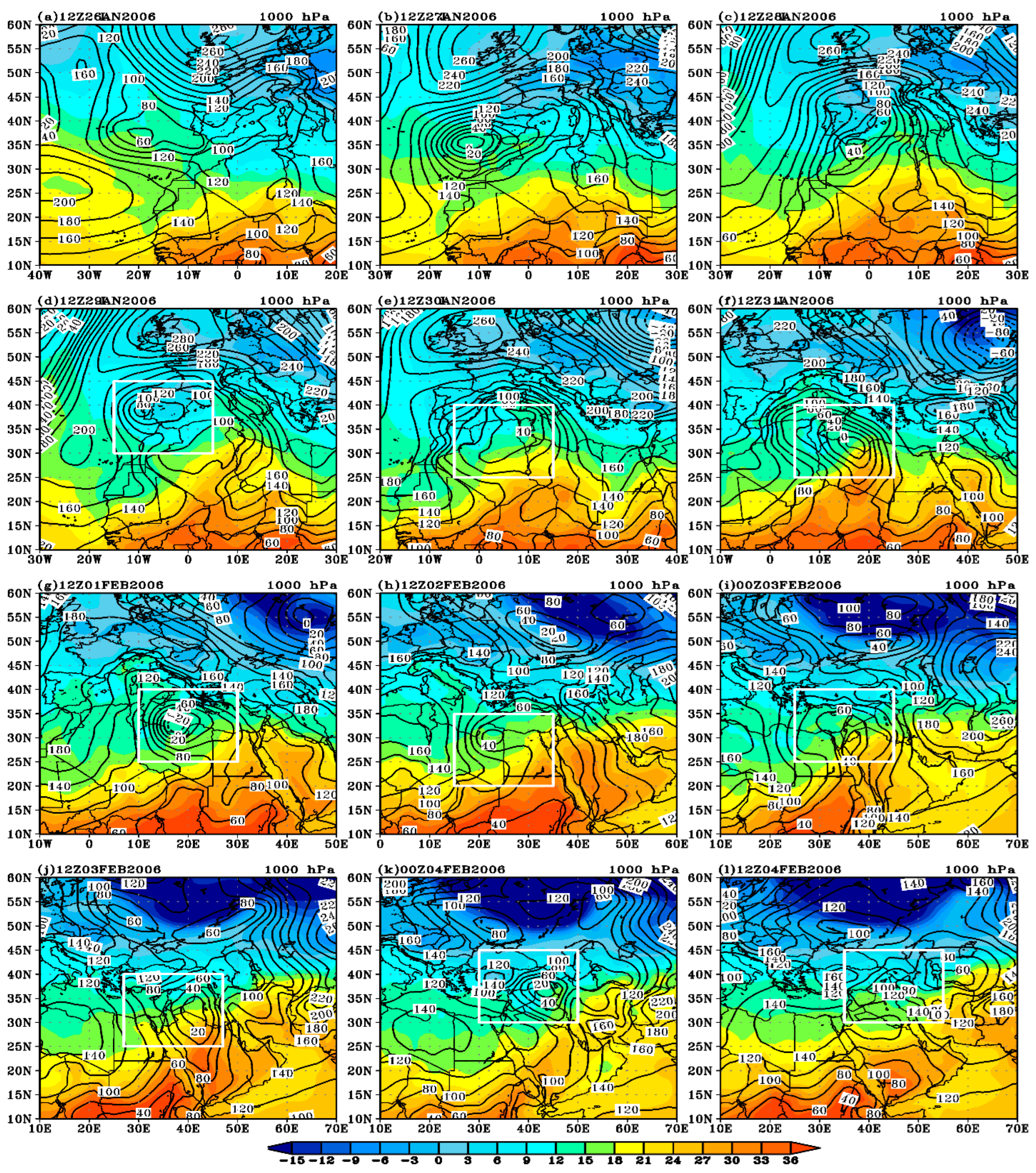
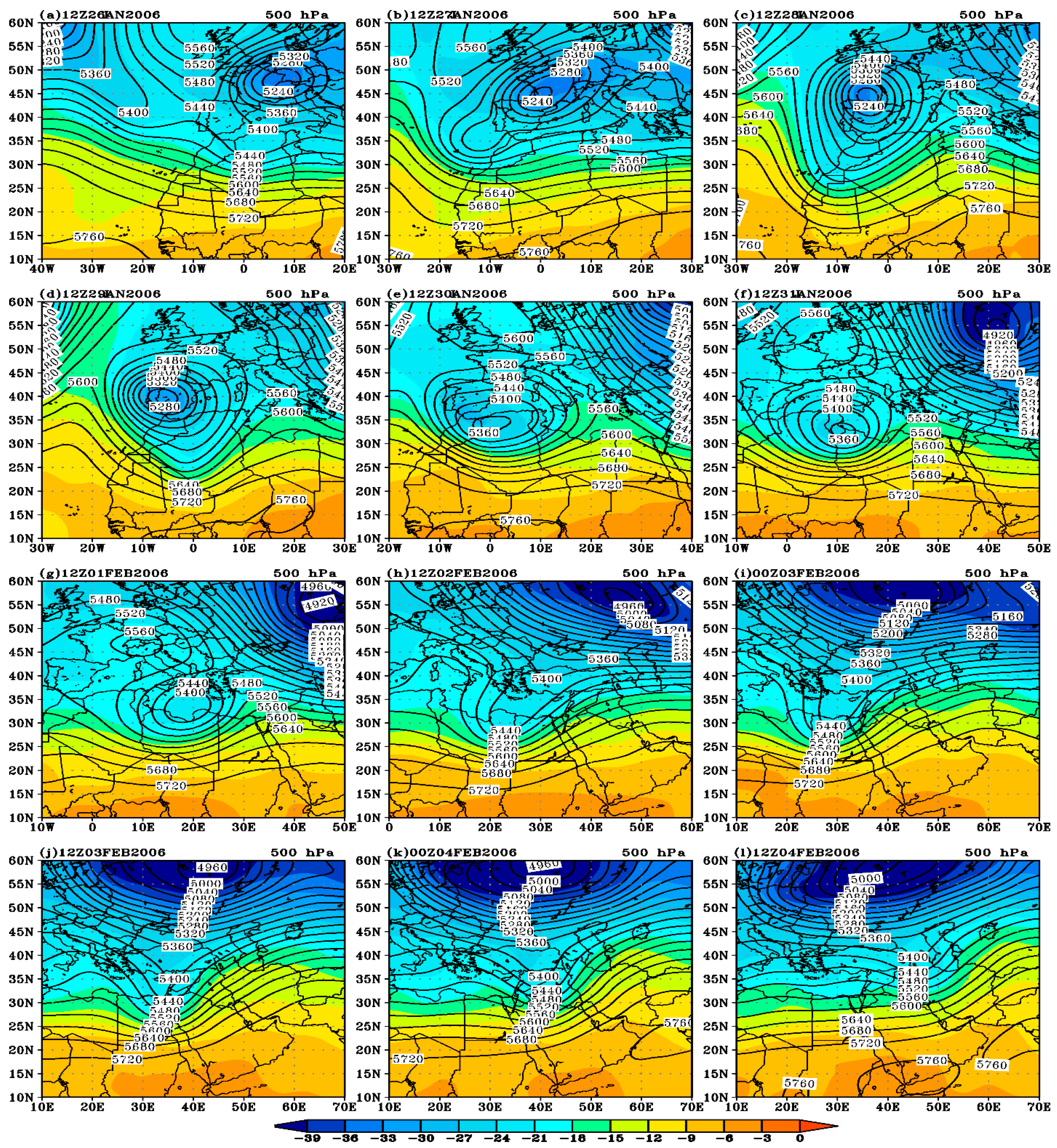
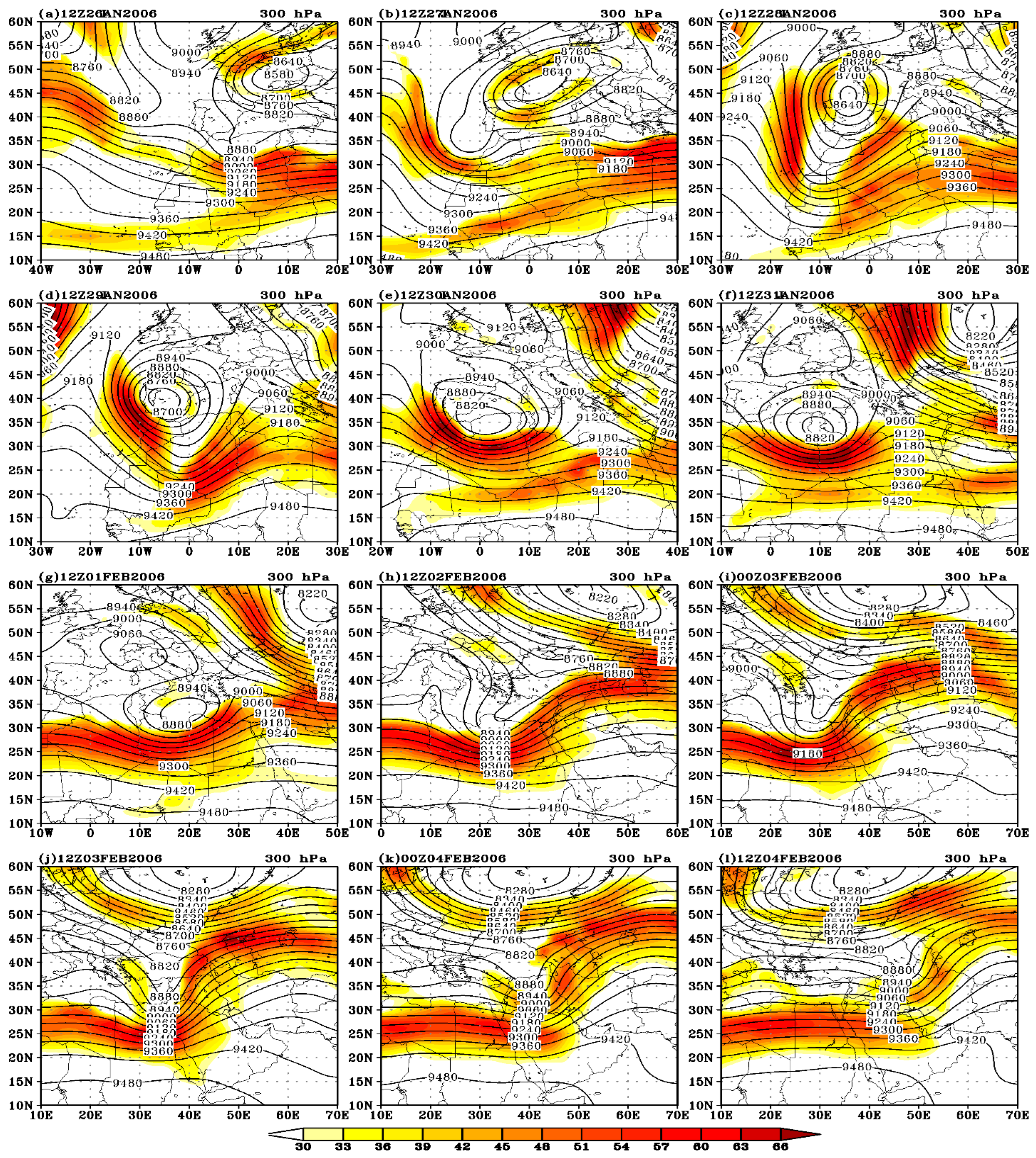

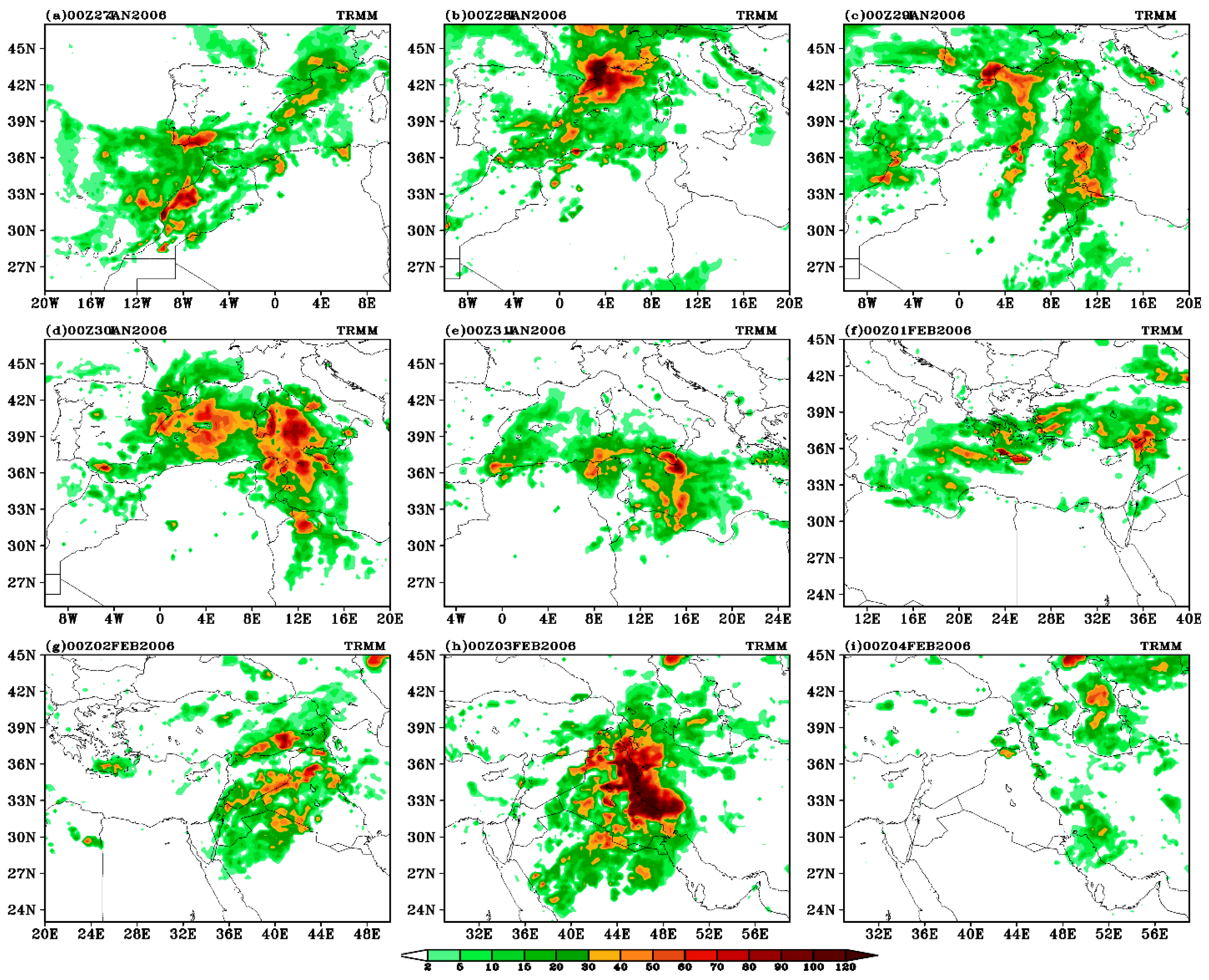

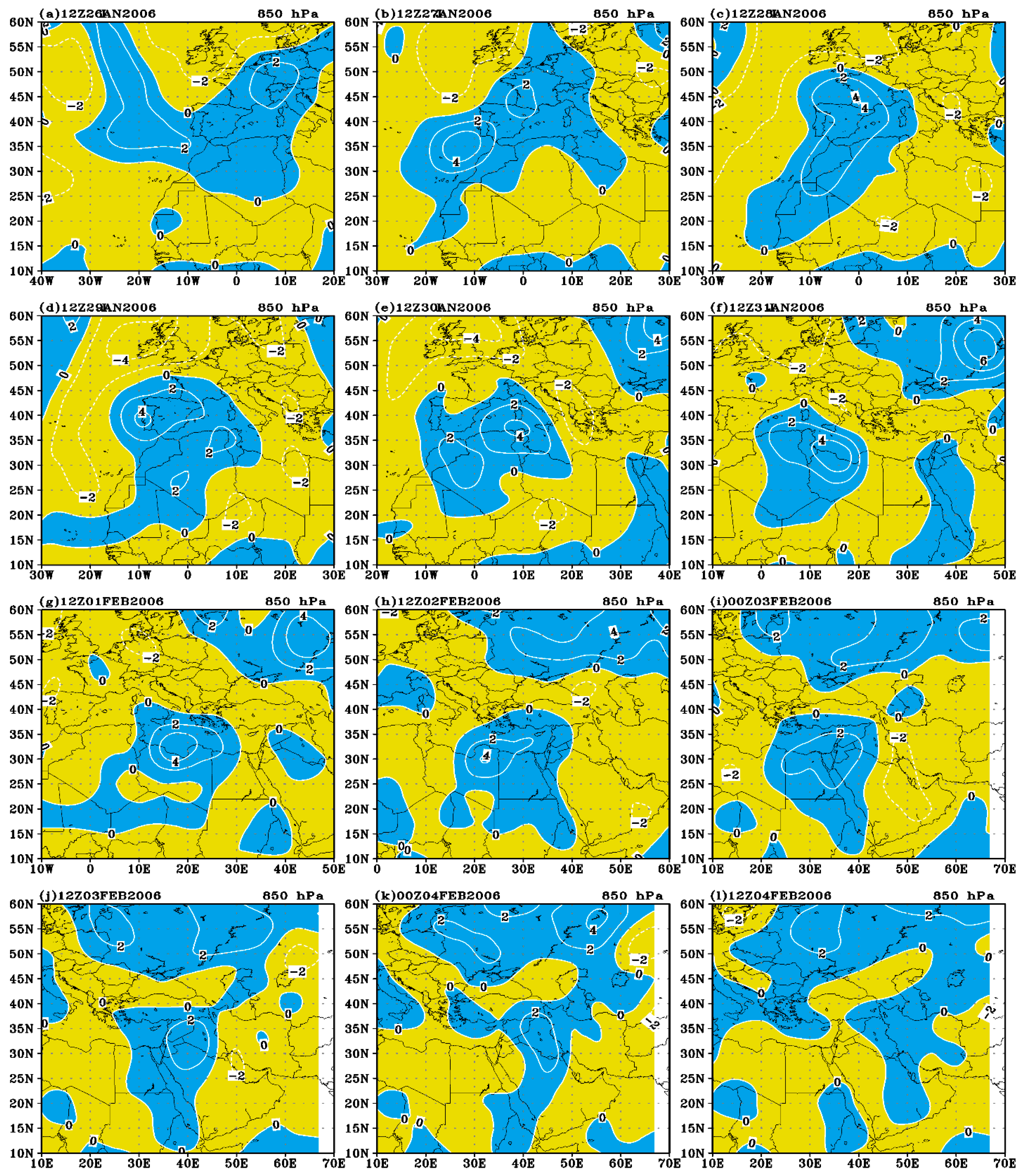

| LEVEL | KE | ∂KE/∂t | −∇.(VKE) | ∂ωKE/∂P | −V.∇ φ | D(K) | −V.∇φ + D(K) |
|---|---|---|---|---|---|---|---|
| 100 | 31.40 | −0.23 | −1.20 | 9.44 | 14.99 | −23.47 | −8.48 |
| 150 | 97.29 | 0.08 | 2.62 | 6.74 | 22.40 | −31.68 | −9.28 |
| 200 | 111.66 | −0.44 | 6.38 | 4.26 | 49.45 | −60.53 | −11.08 |
| 250 | 113.36 | −0.13 | 8.54 | 4.69 | 54.36 | −67.73 | −13.37 |
| 300 | 147.94 | 0.64 | 14.21 | 0.44 | 29.78 | −43.79 | −14.01 |
| 400 | 120.17 | 0.25 | 7.53 | −3.64 | 22.30 | −25.93 | −3.64 |
| 500 | 108.03 | −0.96 | 3.62 | −8.23 | 67.41 | −63.76 | 3.65 |
| 700 | 43.06 | −0.30 | 0.09 | −8.88 | 0.89 | 7.60 | 8.49 |
| 850 | 16.86 | −0.08 | −0.44 | −3.30 | −2.67 | 6.33 | 3.66 |
| 925 | 9.37 | −0.10 | −0.36 | −1.20 | −4.50 | 5.96 | 1.46 |
| 1000 | 2.28 | −0.02 | −0.08 | −0.33 | −2.94 | 3.32 | 0.39 |
| Mean | 72.86 | −0.12 | 3.72 | 0 | 22.86 | −26.7 | 22.86 |
| Date/Time | K | ∂K/∂t | −V.∇ φ | −∇. (KV) | D(K) | −V.∇ φ +D(K) |
|---|---|---|---|---|---|---|
| 29Jan-00 | 54.02 | 0.35 | −71.26 | 2.52 | 69.09 | −2.17 |
| 29Jan-06 | 54.47 | 0.36 | −77.94 | 2.79 | 75.52 | −2.42 |
| 29Jan-12 | 55.59 | 0.41 | −79.69 | 1.33 | 78.76 | −0.93 |
| 29Jan-18 | 63.28 | 1.74 | −76.93 | −0.18 | 78.85 | 1.92 |
| 30Jan-00 | 67.84 | 2.10 | −86.12 | −1.36 | 89.57 | 3.45 |
| 30Jan-06 | 81.78 | 2.83 | −9.02 | 4.42 | 7.43 | −1.59 |
| 30Jan-12 | 80.46 | 2.26 | 43.65 | 11.57 | −52.96 | −9.31 |
| 30Jan-18 | 56.16 | −0.25 | 52.17 | 13.64 | −66.06 | −13.89 |
| 31Jan-00 | 53.83 | −0.80 | 30.06 | 9.19 | −40.04 | −9.98 |
| 31Jan-06 | 79.73 | 1.21 | 30.29 | 12.53 | −41.62 | −11.33 |
| 31Jan-12 | 79.80 | 1.03 | 29.55 | 10.58 | −39.10 | −9.55 |
| 31Jan-18 | 80.25 | −0.20 | 17.56 | 6.14 | −23.90 | −6.34 |
| 01Feb-00 | 80.37 | −0.40 | 30.11 | 6.50 | −37.00 | −6.90 |
| 01Feb-06 | 79.45 | −1.04 | 32.08 | 6.45 | −39.56 | −7.49 |
| 01Feb-12 | 76.86 | −1.75 | 23.19 | 4.68 | −29.63 | −6.43 |
| 01Feb-18 | 71.89 | −2.30 | 2.70 | −0.44 | −4.57 | −1.87 |
| 02Feb-00 | 70.49 | −2.52 | 5.68 | −0.71 | −7.50 | −1.82 |
| 02Feb-06 | 82.58 | −1.69 | 30.36 | 2.10 | −34.15 | −3.79 |
| 02Feb-12 | 94.16 | −0.24 | 26.18 | 2.00 | −28.42 | −2.25 |
| 02Feb-18 | 96.38 | 1.37 | 56.46 | 7.83 | −62.93 | −6.46 |
| 03Feb-00 | 79.03 | −0.47 | 86.04 | 5.02 | −91.52 | −5.48 |
| 03Feb-06 | 78.96 | −0.02 | 87.57 | 5.30 | −92.88 | −5.32 |
| 03Feb-12 | 80.63 | 0.49 | 61.51 | 0.70 | −61.72 | −0.21 |
| 03Feb-18 | 83.00 | 0.42 | 79.44 | 1.91 | −80.93 | −1.49 |
| 04Feb-00 | 61.80 | −1.47 | 80.81 | −5.75 | −76.53 | 4.28 |
| 04Feb-06 | 64.69 | −2.59 | 80.98 | −5.19 | −78.38 | 2.60 |
| 04Feb-12 | 59.59 | −2.04 | 85.78 | −3.18 | −84.64 | 1.14 |
| Ave | 72.86 | −0.12 | 22.86 | 3.72 | −26.70 | −3.84 |
Disclaimer/Publisher’s Note: The statements, opinions and data contained in all publications are solely those of the individual author(s) and contributor(s) and not of MDPI and/or the editor(s). MDPI and/or the editor(s) disclaim responsibility for any injury to people or property resulting from any ideas, methods, instructions or products referred to in the content. |
© 2025 by the author. Licensee MDPI, Basel, Switzerland. This article is an open access article distributed under the terms and conditions of the Creative Commons Attribution (CC BY) license (https://creativecommons.org/licenses/by/4.0/).
Share and Cite
Samman, A.E. Synoptic and Dynamic Analyses of an Intense Mediterranean Cyclone: A Case Study. Climate 2025, 13, 126. https://doi.org/10.3390/cli13060126
Samman AE. Synoptic and Dynamic Analyses of an Intense Mediterranean Cyclone: A Case Study. Climate. 2025; 13(6):126. https://doi.org/10.3390/cli13060126
Chicago/Turabian StyleSamman, Ahmad E. 2025. "Synoptic and Dynamic Analyses of an Intense Mediterranean Cyclone: A Case Study" Climate 13, no. 6: 126. https://doi.org/10.3390/cli13060126
APA StyleSamman, A. E. (2025). Synoptic and Dynamic Analyses of an Intense Mediterranean Cyclone: A Case Study. Climate, 13(6), 126. https://doi.org/10.3390/cli13060126






